Onam Festival Informations- History, Facts and Rituals of Onam
Read this article about Onam festival informations,history of onam,facts about onam and rituals of Onam. Onam is a very important festival for the people of Kerala. The festival is being celebrated with a lot of enthusiasm since ages.
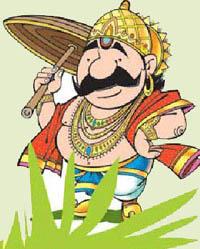 Onam is known as the national festival of Kerala state in India. It is celebrated in the month of Chingam according to the Malayalam calendar. Onam is traditionally a Hindu festival but it has come to be known as a secular festival now where people of all communities, caste and creed celebrate the festival with the same enthusiasm and joy. The festival lasts for ten days, starting from Atham nakshatram (star) until the Thiruvonam nakshatram. In some parts of Kerala, the two days after Thiruvonam are also important. The festivities of Onam include snake boat races, grand feast, pookalam designs, traditional dances and games. For the complete span of ten days, people wake up early in the morning, take a bath and offer prayers at nearby temples before starting off the day's work.
Onam is known as the national festival of Kerala state in India. It is celebrated in the month of Chingam according to the Malayalam calendar. Onam is traditionally a Hindu festival but it has come to be known as a secular festival now where people of all communities, caste and creed celebrate the festival with the same enthusiasm and joy. The festival lasts for ten days, starting from Atham nakshatram (star) until the Thiruvonam nakshatram. In some parts of Kerala, the two days after Thiruvonam are also important. The festivities of Onam include snake boat races, grand feast, pookalam designs, traditional dances and games. For the complete span of ten days, people wake up early in the morning, take a bath and offer prayers at nearby temples before starting off the day's work.
Onam is a time for reunion among family members as most of the people who work abroad also have public holidays on the occasion which allow them to pack their bags and join their family members to celebrate the joyous time. Children also love Onam as it is a time when their long-pending wishes are fulfilled by their parents and other elders. As the mood in the air is filled with joy, parents rarely refuse anything to the kids. Onam is also a time to gift new clothes to loved ones and close relatives. The festival usually falls in the period from August to September. It initiates the harvest period of Kerala. Other than dances and games, there are some rituals which are followed during the festival. The people of Kerala believe that the legendary King Mahabali (also known as King Maveli), who is loved by everyone, visits the state of Kerala during the time of Onam.
The traditional dances of Onam festival include Kaikottikali (which is also called Thiruvathirakali), Kummattikali, Puli kali, Thumbi Thullal and Kathakali. Each of these dance styles are unique in nature and you can find them only in Kerala. The costumes and dance steps are also very rare and interesting. The traditional games of Onam festival include Kayyankali, Attakalam, Kutukutu, Ambeyyal and Talappanthukali. All these games are played only by men as most of them involve fierce fighting which needs a lot of physical strength and stamina. Ambeyyal is a game of shooting whereas Kayyankali and Attakalam are combat games which are very violent in nature. Talappanthukali is a ball game whereas Kutukutu is a Kerala version of the game of Kabaddi.
On the tenth day of Onam, every household prepares and serves a grand feast which is strictly vegetarian and includes typical Kerala dish items such as sambar, avial, rasam, koottukari, pickles etc which are served on a banana leaf. This feast is known as sadya or Onasadya. The Onasadya is also served in hotels and temples. Another important feature of Onam festival are the snake boat races or vallamkali which take place in many parts of Kerala. The most famous snake boat races are Aranmula Boat Race and The Nehru Trophy Boat Race. The race consists of almost 150 oarsmen in one boat itself. They move their oars together in a harmonious and synchronised way which is very important as one mistake made by one oarsman may lead to the overturning of the boat.History of Onam festival
Onam is a very important part of the life of Malayalees. It has been a part of their culture since ages. As far as evidences and facts go, it is said that Onam festival began somewhere around 800 A.D. The origin of Onam festival goes as follows. There once lived a strong and able ruler called King Mahabali. He was actually an asura (demon) but did not have any bad qualities of an asura. He was the grandson of Prahlad. King Mahabali was the ruler of Kerala. Just like Prahlad, he was also a strong worshipper and devotee of Lord Vishnu. The people of Mahabali's kingdom loved and respected him very much as he was an able king who took care of his subjects extremely well and made such an environment where there was no sorrow, poverty or anything that was negative. Subsequently, he became the king of all the three worlds. Needless to say, this popularity of King Mahabali made some of the other gods (devas) envious who went to Lord Vishnu and requested him to do something that would put Mahabali's reign to an end. 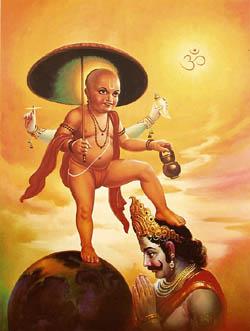 But Lord Vishnu made them understand that since Mahabali is doing such a good job of taking care of his subjects, he is even eligible to turn into a sura (opposite of asura). In Hindu mythology, sura is a person with more of positive thoughts whereas an asura is a person who possesses more negative thoughts. He also reminded the jealous gods that jealousy is a bad quality and possessing it will only make them asuras. But Lord Vishnu also wished to test Mahabali's goodness and so he went to earth in the disguise of a Brahmin called Vamana.
But Lord Vishnu made them understand that since Mahabali is doing such a good job of taking care of his subjects, he is even eligible to turn into a sura (opposite of asura). In Hindu mythology, sura is a person with more of positive thoughts whereas an asura is a person who possesses more negative thoughts. He also reminded the jealous gods that jealousy is a bad quality and possessing it will only make them asuras. But Lord Vishnu also wished to test Mahabali's goodness and so he went to earth in the disguise of a Brahmin called Vamana.
Meanwhile, Mahabali was in the process of a yagam (sacrificial ritual) in which he declared that he would give away anything that he possessed to anyone who wished to have it during the ritual. Lord Vishnu took this situation to his advantage and went in front of Mahabali as Vamana. King Mahabali, who was well known for his helpful and noble nature received Vamana and treated him very well. After sometime Mahabali got to know from a priest that Vamana is none other than Lord Vishnu himself and he was also advised not to promise to give away his possessions to the lord as he might not have anything left with him in the end. But it was not in Mahabali's character to break his promise.
Thus, Vamana began to make his demands. Slowly and gradually he started to demand Mahabali's entire kingdom which was given to him without any protests or hesitance from the king. Vamana said that he wanted three feet of land from Mahabali. Vamana began to grow in size and became so huge that he could cover the entire heaven with one foot and entire earth with the other foot. Finally when there was just one piece of land left, Mahabali requested Vamana to place his last step on his head in order to acquire the last land too. Vamana did just as Mahabali requested and while placing his leg on his head, Vamana pushed him into patala (hell or the underworld). Lord Vishnu was so impressed with Mahabali's devotion and sincerity that he made him the king of hell. Mahabali was also given the permission to visit his people on Earth once in a year. This is the reason why the festival of Onam is celebrated in honour of the beloved King Mahabali as his return to his kingdom on earth.Other facts of Onam
There is a small interesting story also that lies behind the initiation of snake boat races. It is believed that many years ago, a noble Brahmin man called Katoor Mana used to visit the Aranmula temple and Pamba river for worship daily. On one such day after he finished offering his prayers, he wished to find a poor person so that he could do a noble cause of feeding the person. But even after a long wait he did not see anyone nearby. So ultimately he closed his eyes again and offered his prayers to Lord Krishna. After this when Katoor Mana reopened his eyes, he saw a poor boy standing right in front of him. This made him very happy and he fulfilled his wish of offering some food to the poor boy. The amazing fact is that the boy disappeared soon after he finished eating the meal. Katoor Mana wished to search for the boy in the surroundings. He kept sighting the boy around the temple many times but the boy disappeared very soon after that. This made Katoor Mana faith's in god all the more strong as he believed that it was the lord himself who made an appearance before him. Thus, Katoor Mana decided to offer food to Aranmula temple each and every year during the Onam festival. But he had to make sure that the food was protected from the pirates who used to make their journeys in the Pamba river. For this purpose, he used to request the people who owned the snake boats to give him company till the temple. As Katoor Mana was doing a very noble job, many of the snake boats voluntarily came forward to help him in his cause and protected the food during the journey to the temple. This was the beginning of how the snake boat races started. This incident led to many other developments which ultimately brought the snake boat races to such a national level.
Another story connected to the festival of Onam is as follows. Long time ago, some local men were sailing in a boat called Palliyodam. The boat was completely filled with all sorts of eatables. Suddenly, the boat got stuck in between the river and no efforts by the men could make it budge and sail properly on the water. A man called Bhattathiripad was the main oarsman of the boat. Having no other choice, he went out to seek some help from a nearby hut. Inside the hut, Bhattathiripad found a small boy and a poor widow who were crying out of deep hunger. Bhattathiripad was a kind hearted person and he could not witness such a sight. So he immediately went to the boat, took out some food from it and gave it to the boy and widow. Surprisingly, the boat which was stuck in the river all the while suddenly started moving properly. Ever since, people make it a point to feed poor people atleast on the occasion of Onam.Rituals connected with Onam festival
1. Maveli Puja - 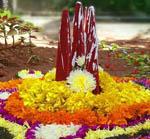 Maveli Puja is a very important ritual of Onam festival which is conducted on the ninth day (Uthradam) and tenth day (Thiruvonam) of Onam. It is usually performed by the people of Northern Kerala. It is done in honour of King Mahabali who is also known as King Maveli. The puja is done early morning on all the ten days of the festival with idols of Mahabali formed using earthern mounds or clay and later painted in red colour. The man-made idols are placed at the entrance in front of the house. The mounds are also called as 'Thrikkakara Appan'. The eldest member or the bread winner of the family usually performs the puja. After the puja ends, the male members of the family shout loudly rhythmically in joy. This weird ritual is called as 'Aarppu Vilikkukal'.
Maveli Puja is a very important ritual of Onam festival which is conducted on the ninth day (Uthradam) and tenth day (Thiruvonam) of Onam. It is usually performed by the people of Northern Kerala. It is done in honour of King Mahabali who is also known as King Maveli. The puja is done early morning on all the ten days of the festival with idols of Mahabali formed using earthern mounds or clay and later painted in red colour. The man-made idols are placed at the entrance in front of the house. The mounds are also called as 'Thrikkakara Appan'. The eldest member or the bread winner of the family usually performs the puja. After the puja ends, the male members of the family shout loudly rhythmically in joy. This weird ritual is called as 'Aarppu Vilikkukal'.
2. Onakkodi or Onapudava -  Since Onam is a happy occasion and it is the beginning of something new, people wear and gift new clothes on this day. Loved ones and close relatives also gift each other new clothes which are known as Onakkodi or Onapudava. It is usually the eldest member of the family who distributes the new clothes. Even the servants of the house are gifted with Onapudava.
Since Onam is a happy occasion and it is the beginning of something new, people wear and gift new clothes on this day. Loved ones and close relatives also gift each other new clothes which are known as Onakkodi or Onapudava. It is usually the eldest member of the family who distributes the new clothes. Even the servants of the house are gifted with Onapudava.
3. Onakkazhcha - Onakkazhacha is another age-old tradition that is followed even in today's world in the interior parts of Kerala during Onam. In this tradition, the farmers and tenants gift the produce of their hard work in the farms to the Karnavar (eldest member of the family) of the Nair Tharawad (household). In return for this, the farmers receive tokens of small gifts, sumptuous meals or sweets from the Karnavar.
4. Kayyankali or Onathallu - Kayyankali is basically a game that is played between the male members of the family. But it is also a ritual that is followed during the festival of Onam. It is a very violent game and is known as a combat game. The people who take part in it should have immense strength and stamina. The game is so violent that there are cases where even death has occurred during the course of the game.
5. Thripunithura Athachamayam - 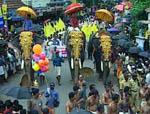 Thripunithura Athachamayam is another important ritual of Onam festival. It is performed on the first day (Atham) of the ten-day long festival. It is performed in a temple in Thrikkakara near the city of Kochi which is considered as the abode of King Mahabali. The start of Onam festival is marked across Kerala with a grand procession called Athachamayam that begins from Thripunithura near Kochi. The procession consists of elegantly decorated elephants, performances of folk art forms and traditional music. History shows that this was a tradition followed by the rulers of erstwhile Kochi who used to travel till Thripunithura fort. The people of Kerala follow this tradition even now although the king is no longer there.
Thripunithura Athachamayam is another important ritual of Onam festival. It is performed on the first day (Atham) of the ten-day long festival. It is performed in a temple in Thrikkakara near the city of Kochi which is considered as the abode of King Mahabali. The start of Onam festival is marked across Kerala with a grand procession called Athachamayam that begins from Thripunithura near Kochi. The procession consists of elegantly decorated elephants, performances of folk art forms and traditional music. History shows that this was a tradition followed by the rulers of erstwhile Kochi who used to travel till Thripunithura fort. The people of Kerala follow this tradition even now although the king is no longer there.
6. Pookalam designing - 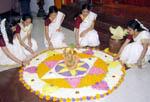 Making pookalam designs are also followed as a major ritual by every household during the period of Onam. For giving King Mahabali a pleasant welcome, people make creative pookalam designs in front of their homes. It is almost like a competition between households as there is a saying that the king only visits those homes where the pookalam design is extremely beautiful and inviting. A pookalam design is a floral design just like a rangoli, the only difference being that a rangoli is made with powdered colours whereas a pookalam is made with fresh flowers. The pookalam design is made early in the morning by the maidens of the house. On the first day of the ten-day period of Onam, only a small design of pookalam is made on the floor at the entrance of the house. Day by day, this design has to be made bigger and better until the tenth day which is the main day of the festival. Another factor of pookalam is that a particular designated flower has to be used on each day. Each and every flower that is used in a pookalam represents a particular deity from the Hindu mythology. Nowadays there are pookalam design competitions that take place all over Kerala at offices, colleges, schools etc during Onam.
Making pookalam designs are also followed as a major ritual by every household during the period of Onam. For giving King Mahabali a pleasant welcome, people make creative pookalam designs in front of their homes. It is almost like a competition between households as there is a saying that the king only visits those homes where the pookalam design is extremely beautiful and inviting. A pookalam design is a floral design just like a rangoli, the only difference being that a rangoli is made with powdered colours whereas a pookalam is made with fresh flowers. The pookalam design is made early in the morning by the maidens of the house. On the first day of the ten-day period of Onam, only a small design of pookalam is made on the floor at the entrance of the house. Day by day, this design has to be made bigger and better until the tenth day which is the main day of the festival. Another factor of pookalam is that a particular designated flower has to be used on each day. Each and every flower that is used in a pookalam represents a particular deity from the Hindu mythology. Nowadays there are pookalam design competitions that take place all over Kerala at offices, colleges, schools etc during Onam.

Anil, you always have wetrtin well. I remember those Kerala photos when you showed them to us. You had explained something about the photo with 3 coconut trees and I was quite lost. Written words are eternal whereas spoken words can say much more although they live for the moment.A thought on a tangent: If Mahabali was such a kind king to his subjects, why on earth did Vishnu sent him to 'patal'. Was it because he belonged to different race?